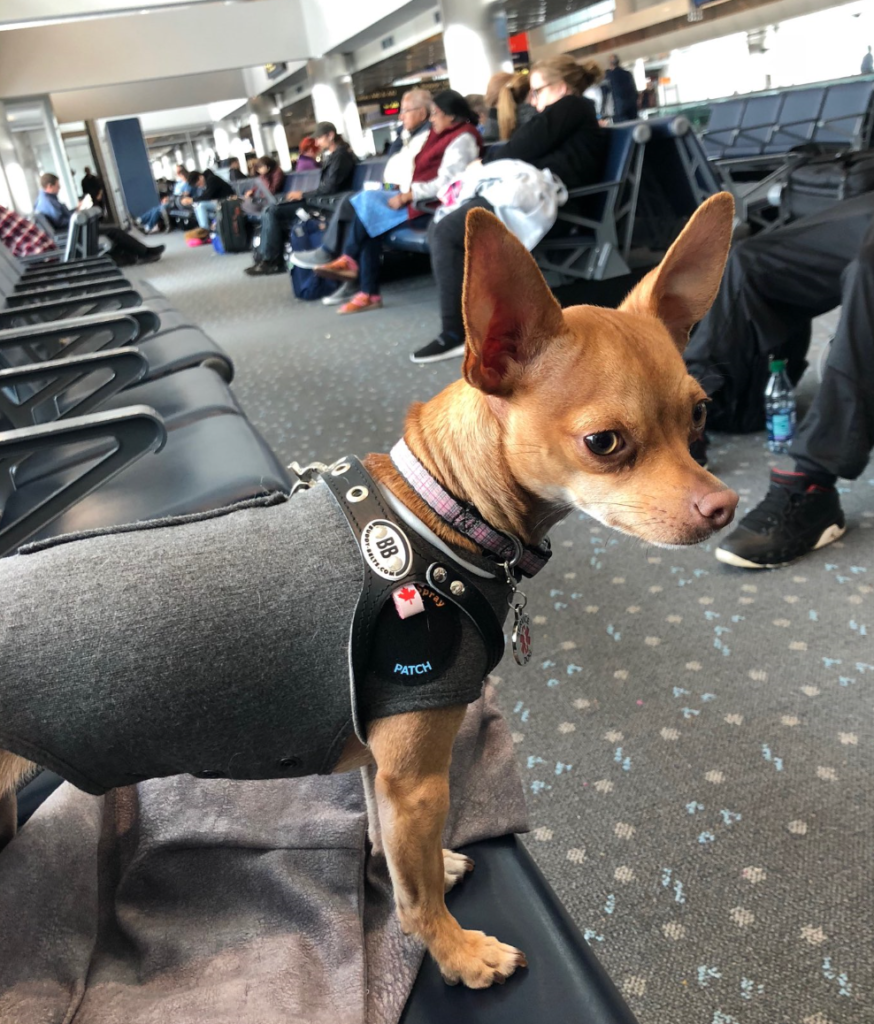Have Dog, Will Travel
So I went on a business trip to visit my company headquarters this last week and I took my dog with me. Yes, you heard that right, my dog.
My 10lb Chihuahua/Basenji mix dog, Esme, is actually a service dog, which means she can go almost anywhere with me. She’s gone through a good amount of training to do so and honestly, she travels better than most adults. Although she’s had all the training, the fact can’t be ignored that she was a severely abused puppy and still suffers some residual effects of this. The task she performs is at night for a sleep disorder, but as I travel, it’s important to have her travel and is socialized as part of her training and she’s in that odd category of service animal that doesn’t fit most people’s idea of what a service dog is.
She’s an adorable animal and as loving as she is to me, it can be difficult for other people to understand, it’s not acceptable to come into her space and try to pet her or that as friendly as she may seem, she still isn’t too keen on new people. Her connection to me is part of her job and it’s necessary for her to perform her job, but it will also result in her being more protective of me if you come into my space. I’ve had to get a “Do Not Pet” label for her Service Dog harness due to this.
The How
Now, with that said, I’ve been asked how to best travel with a dog. I’ve never found it that difficult to still travel with Esme, a small backpack and my 20 inch suitcase, but there are some fast rules and tips to know that can make the best of the trip.
- Dogs travel rather inexpensively on flights. Most airlines have become quite pet friendly, but the animal must remain in a small kennel that will fit under the seat in front of your own unless its an ESA, (Emotional Support Animal) or service animal.
- Train your dog. If you plan on traveling with them, train them not to bark and travel with them in a car extensively before air travel to get them accustomed to sitting still and being content with the travel arrangements.
- Make them as comfortable as possible.
- Get a thundershirt or similar to help ease the stress of the travel.
- Use a pheromone spray that will help to relax the dog. You spray it on a blanket or on the thundershirt, there’s a special patch.
- If the dog is a small service or ESA dog, consider a pouch. I have people ask me all the time where I got Esme’s Cozy and Dozy Sling. She looks like a little wallaby in it, but she even sleeps in it while I work- typing on my computer, attending meetings. People are just amazed that she’s completely content to snuggle up and snooze in it. It also comes with pockets for my cell phone when I’m getting on the plane, has a short leash with hook to secure her and a couple zip pockets to keep necessities.
- Collapsible food and water bowl. Often made of silicone, they collapse flat and fit in a zipper pocket. I keep a collapsible water bottle with me and often give her water in her bowl from it as we travel.
- Take your dogs customary food with you in a Tupperware, along with their favorite toys. Esme’s is a Nylabone that she’s happy to chew on when we relax for the evening.
- And take a roll of dog poop bags. Yeah, you’re going to need those and often at the most inopportune times.
- Know where the relief areas are for the departure and arrival airport are. Most airports now have them and it’s important to know, so look online.
- Make sure they are up to date on all their vaccinations and have all their tags present on their collar.
- If they are an ESA or Service dog, you should have a letter or documentation showing this.
- Make sure to call the airlines BEFORE checking in for your flight so they can add your pet to your ticket. Then check in, otherwise they may have to “uncheck” you in to add the pet information.
- Book with a pet-friendly hotel, like aLoft and call beforehand to find out what accommodations the hotel has for pets. I’ve had ones that just accepted pets and then ones that are pet-friendly and there’s a big difference. Ones that are pet-friendly will often have quiet yards with receptacles for pet refuse, walking areas and rooms set aside that have easy access to the outdoors for early morning outings, etc. aLoft actually has dog beds, bowls and pet yards. When trying to make a pet comfortable in a new surrounding, this can make a huge difference.
The day of a trip, I feed her a little earlier, ensure she has at least two hours afterwards to have enough time to relieve herself and then give her only a little bit of water until the flight. I won’t feed her again until we’re at the hotel and it gives her a reason to be happy to be in the new place, too. This will keep her from getting ill if their are turbulents, etc.
I’m sure there’s other things I’m doing to help make Esme a good traveler, but these are some of the tips I can offer to make it easier for everyone involved. I love that people are astounded what a great traveling companion she is. I’d do anything to take away the abuse she went through as a puppy before I rescued her at 5 months old, but she’s got it pretty good now. She’s earned it and she earns her keep.


